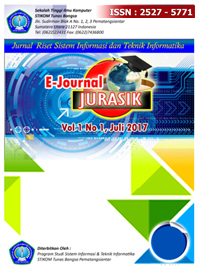Algoritma Naive Bayes Dalam Klasifikasi Lokasi Pembangunan Sumber Air
Abstract
Full Text:
PDFReferences
M. G. Sadewo, A. P. Windarto, and D. Hartama, “Penerapan Datamining Pada Populasi Daging Ayam Ras Pedaging Di Indonesia Berdasarkan Provinsi Menggunakan K-Means,” InfoTekJar (Jurnal Nasional Informatika dan Teknologi Jaringan), vol. 2, no. 1, pp. 60–67, 2017.
I. Parlina, A. P. Windarto, A. Wanto, and M. R. Lubis, “Memanfaatkan Algoritma K-Means dalam Menentukan Pegawai yang Layak Mengikuti Asessment Center untuk Clustering Program SDP,” CESS (Journal of Computer Engineering System and Science), vol. 3, no. 1, pp. 87–93, 2018.
M. G. Sadewo, A. P. Windarto, and A. Wanto, “Penerapan Algoritma Clustering dalam Mengelompokkan Banyaknya Desa/Kelurahan Menurut Upaya Antisipasi/ Mitigasi Bencana Alam Menurut Provinsi dengan K-Means,” KOMIK (Konferensi Nasional Teknologi Informasi dan Komputer), vol. 2, no. 1, pp. 311–319, 2018.
R. W. Sari, A. Wanto, and A. P. Windarto, “Implementasi Rapidminer dengan Metode K-Means (Study Kasus : Imunisasi Campak pada Balita Berdasarkan Provinsi),” KOMIK (Konferensi Nasional Teknologi Informasi dan Komputer), vol. 2, no. 1, pp. 224–230, 2018.
S. Sudirman, A. P. Windarto, and A. Wanto, “Data Mining Tools | RapidMiner : K-Means Method on Clustering of Rice Crops by Province as Efforts to Stabilize Food Crops In Indonesia,” IOP Conference Series: Materials Science and Engineering, vol. 420, no. 12089, pp. 1–8, 2018.
A. P. Windarto, L. S. Dewi, and D. Hartama, “Implementation of Artificial Intelligence in Predicting the Value of Indonesian Oil and Gas Exports With BP Algorithm,” International Journal of Recent Trends in Engineering & Research (IJRTER), vol. 3, no. 10, pp. 1–12, 2017.
I. S. Sulistyorini, M. Edwin, and A. S. Arung, “ANALISIS KUALITAS AIR PADA SUMBER MATA AIR DI KECAMATAN KARANGAN DAN KALIORANG KABUPATEN KUTAI TIMUR,” Jurnal Hutan Tropis, vol. 4, no. 1, pp. 64–76, 2016.
D. L. Fithri, “MODEL DATA MINING DALAM PENENTUAN KELAYAKAN PEMILIHAN TEMPAT TINGGAL MENGGUNAKAN METODE NAIVE BAYES,” Jurnal SIMETRIS, vol. 7, no. 2, pp. 725–730, 2016.
H. Brilian Argario, N. Hidayat, and R. Kartika Dewi, “Implementasi Metode Naive Bayes Untuk Diagnosis Penyakit Kambing ( Studi Kasus : UPTD . Pembibitan Ternak dan Hijauan Makanan Ternak Kec. Singosari Malang),” Jurnal Pengembangan Teknologi Informasi dan Ilmu Komputer, vol. 2, no. 8, pp. 2719–2723, 2018.
W. Muslehatin, M. Ibnu, and Mustakim, “Penerapan Naïve Bayes Classification untuk Klasifikasi Tingkat Kemungkinan Obesitas Mahasiswa Sistem Informasi UIN Suska Riau,” Seminar Nasional Teknologi Informasi, Komunikasi dan Industri (SNTIKI), pp. 18–19, 2017.
A. Saleh, “Implementasi Metode Klasifikasi Naïve Bayes Dalam Memprediksi Besarnya Penggunaan Listrik Rumah Tangga,” Citec Journal, vol. 2, no. 3, pp. 207–217, 2015.
S. F. Rodiyansyah, “NAÏVE BAYES CLASSIFICATION UNTUK PENENTUAN KELAYAKAN DONOR DARAH,” pp. 156–159, 2014.
Y. I. Kurniawan, “PERBANDINGAN ALGORITMA NAIVE BAYES DAN C.45 DALAM KLASIFIKASI DATA MINING,” Jurnal Teknologi Informasi dan Ilmu Komputer (JTIIK), vol. 5, no. 4, pp. 455–464, 2018.
T. Arifin, “METODE DATA MINING UNTUK KLASIFIKASI DATA SEL NUKLEUS DAN SEL RADANG BERDASARKAN ANALISA TEKSTUR,” Informatika, vol. II, no. 2, pp. 425–433, 2015.
M. Guntur, J. Santony, and Yuhandri, “Prediksi Harga Emas dengan Menggunakan Metode Naïve Bayes dalam Investasi untuk Meminimalisasi Resiko,” Jurnal RESTI(Rekayasa Sistem dan Teknologi Informasi), vol. 2, no. 1, pp. 354–360, 2018.
DOI: http://dx.doi.org/10.30645/senaris.v1i0.81
Refbacks
- There are currently no refbacks.
 








